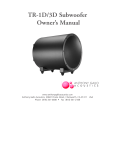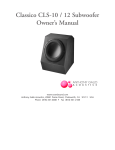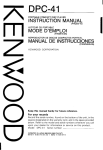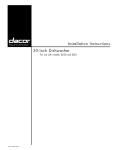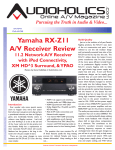Download Anthony Gallo Acoustics TR-3D Owner`s manual
Transcript
Fill Out Warranty Information on back, detach and
return to us for your five year product warranty.
ANTHONY GALLO
Anthony Gallo Acoustics
20841 Prairie Street
Chatsworth, CA 91311 USA
A C O U S T I C S
TR-3 Subwoofer
Owner’s Manual
ANTHONY GALLO
Place
Stamp
Here
A C O U S T I C S
To find a dealer near you, please visit our web site at: www.roundsound.com
Anthony Gallo Acoustics, 20841 Prairie Street, Chatsworth, CA 91311 USA
Phone (800) 459-4183 • (818) 341-4488 • Fax (818) 341-2188
Poor
Fair
Good
Very Good
Owners Manual
Match my decor
Mounting Options
Ease of Set Up
Sound Quality
Size
Build Quality
Excellent
Appearance
What’s the dealers name and address you purchased this Product from ?
What other Speakers did you listen to before choosing the TR-3 Subwoofer ?
Stereo
Home Theatre
Not At All
What type of system did you purchase?
City:
Address:
This symbol alerts the userthat important literature concerning the operation and maintenance of this unit has
been included. Therefore, it should be read carefully in order to avoid any problems.
Name:
c
m
This symbol warns user that uninsulated voltage within the unit may have sufficient magnitude
to cause electric shockl. Therefor, it is dangerous to make any kind of contact with any part inside this unit.
Somewhat
UNPLUGGED FROM WALL SOCKET. TO FULLY DISENGAGE THE POWER TO THE UNIT,
PLEASE DISCONNECT THE POWER CORD FROM THE AC OUTLET. DO NOT REMOVE COVER
(OR BACK). NO USER SERVICEABLE PARTS INSIDE. REFER SERVICING TO
MANUFACTURER.
Very
CAUTION
m
c
CAUTION: TO REDUCE THE RISK OF ELECTRIC SHOCK, MAKE SURE POWER CORD IS
How influential was your dealer in your decision to purchase the TR-3 Subwoofer ?
MOISTURE. ALSO, DO NOT USE THIS UNIT’S PLUG WITH AN EXTENSION CORD
RECEPTACLE OR OTHER OUTLETS UNLESS THE PRONGS CAN BE FULLY INSERTED.
REFRAIN FROM OPENING THE CABINET AS THERE ARE HIGH VOLTAGE COMPONENTS
INSIDE. REFER SERVICING TO MANUFACTURER.
Telephone:
Email:
Where did you first hear about the TR-3 Subwoofer ?
Zip:
State:
TR-3 Serial #
WARNING
m
c
TO PREVENT FIRE OR SHOCK HAZARDS, DO NOT EXPOSE THIS UNIT TO WATER OR
Introduction
Patented S2 Technology
The patented S2 technology is a very simple, yet very powerful approach to solving various
Welcome to Anthony Gallo Acoustics!
acoustic problems inherent to the internal acoustics of any loudspeaker. With respect to the
acoustic sphere, S2 is a material that will act to neutralize the effect of the Hemholtz resonance
Thank you for purchasing our Anthony Gallo Acoustics TR-3 active subwoofer. To help you get the most
while simultaneously damping internal reflections ("chatter").
out of your new acquisition, please take 10 minutes and read over this owner’s manual. It’ll familiarize
you with the TR-3’s basic features while teaching you certain setup tips on how to optimize its
A further benefit of S2 is in low frequency extension. Because S2 seems to mechanically couple
installation with the remainder of your present loudspeaker system. Let’s begin with a well-known
with the driver at low frequencies, but decouple at mid and high frequencies, it allows the driver to
subject that still bears repeating:
behave as if it were in a larger enclosure to produce lower frequencies than it ordinarily would. In
fact - this is precisely the innovation that made the original Micro possible and where Gallo
Break-In: Like any high-quality loudspeaker system that uses superior drivers, the TR-3 undergoes
speakers truly depart from "me too" spherical speakers.
break-in during which the suspension of its internal spider and the external rubber surround reach their
proper compliance. Break-in is simply a function of x-number of excursions until the springy materials of
Every spherical loudspeaker enclosure has these naturally occurring problems of Hemholtz
the woofer soften to their optimum state. Loud low bass accelerates break-in, lower playback levels
resonance and internal "chatter." This becomes especially problematic when employing full-range
prolong it. After 50 hours of optimal break-in, the TR-3 will have stabilized and perform as intended. Do
drivers such as those found in the Micro and the A'Diva. Thanks to S2, these Gallo products can
not judge its performance prematurely and reserve final adjustments to its gain control after the break-in
truly differentiate themselves from lookalike imitation products - they all fall victim to the problems
period is over.
that S2 solves, which is why you can always count on Gallo products for real high-performance
when the competition falls short.
Basics: The term ‘subwoofer’ is quite descriptive. Sub…marine: below the waters surface;
sub…woofer: below the woofers of your main speakers. Depending on your main speaker’s bass
Combined with our S2-enhanced compact subwoofers, the Micro and the A'Diva create stunning
response, a true subwoofer will be used in one of two ways: Filter or bypass mode. More on that later.
soundscapes of beautiful music and cinematic excitement. S2 has made the Compact Home
Let’s start with an introduction to our Patented S2 Technology.
Theater/Stereo a no-compromise High Definition Audio Experience.
1
2
TR-3 Subwoofer Description
TR-3 Subwoofer Description
The first thing you’ll undoubtedly notice about your new TR-3 is the round enclosure. Why round? The
answer is simple. A sphere is one of the strongest geometric shapes known to man. That’s why we
employ spheres for our Nucleus® speakers. Our subwoofers utilize cylindrical enclosures because we
require larger internal volumes and a flat panel for the controls and amplifier heatsinks. Still, we avail
ourselves of the superior strength that round enclosures offer.
Why would you need bass boost? Every loudspeaker undergoes what is known as roll-off. Somewhere
inside the window of its frequency response, every driver’s output begins to fade. It no longer plays as
loudly as it did in the ‘power band’ of its range. This is true also for all woofers regardless of their size.
The audible onset of roll-off is simply a function of room size and proximity. The larger the room, the
sooner roll-off becomes audible. The woofer no longer benefits from the acoustic gain of boundary
reinforcement and can’t reproduce the lowest bass notes as loudly as the higher ones.The further the
sub is placed from wall or boundary, the sooner roll off becomes audible. These are basic guidelines
and may not apply to your room layout.
Why is cabinet strength so important? Consider the enormous internal air pressures generated by the
woofer’s rear wave. As loud as the TR-3 plays into the room, it plays even louder internally. That’s
because the cubic volume of the enclosure is a lot smaller than your room. Simply put, highperformance subwoofers need to move a lot of air. That demand puts a lot of strain on the cabinet
especially if you want to keep it small to avoid designing a visual eyesore.
Small cabinet plus superior strength equals cylindrical shape. Naturally, we also could have made the
cabinet square or rectangular. Most other manufacturers do. To obtain a similar strength ratio to the TR3’s cylinder, this would have required far thicker walls. Thicker walls are not only more expensive, they
also equate to more mass. More mass means higher energy storage. Higher energy storage muddies
the sound and compromises transient response. Additionally, square and rectangular enclosures suffer
from seams and parallel walls. Parallel walls create internal resonances that interfere with the music
signal. In the end, cylindrical enclosures for subwoofers are best.
The TR-3 offers 0, +3 and +6dB bass equalization settings to become uniquely adaptable to room size.
This depends on the placement of the TR-3 in the room, and it is up to your personal preference where
the TR-3 is placed. A small room probably won’t require any boost. A large one might benefit from full
boost. A medium one might prefer medium boost. You’re in control. Also, you no longer need to update
your subwoofer when it comes time to move into larger quarters. Simply change the EQ setting. Do you
prefer slightly increased bass for Home Theater but flat bass for music? A flick of the switch let’s you
have it both ways.
The TR-3 can play loudly even in larger spaces. Can it be subtle and musical though? Yes. The TR-3 is
no mere boom box. Remember the cylindrical enclosure – it’s not a box at all. How about boom? The
TR-3 does not suffer from the common cabinet resonances of rectangular boxes. That’s why it doesn’t
exhibit the usual smear, fuzz and uncontrolled muddiness of inferior subwoofers. What’s more, we use a
sealed acoustic suspension design without a port. The air trapped inside the cylinder becomes the
restoring force that prevents woofer overshoot and maximizes self-damping. The TR-3 suffers neither
port noise chuffing nor the driver ringing endemic to ported alignments.
Our TR-3 subwoofer is small and housed in a chassis of superior strength yet minimal mass. Can it play
loudly? Absolutely. We use a superior long-throw custom 10” Aluminum Cone woofer and a high-current
300-watt amplifier with up to 6dB of bass boost.
In conclusion, the TR-3 combines air suspension; along with our patented S2 technology, a superior
long-throw aluminum cone driver; a minimum mass enclosure of superior rigidity; a high-current 300watt Class A/B amplifier; powerful bass equalization; and a massive motor system of overbuilt magnet
and voice coil with a strong spider and high-excursion butyl rubber roll surround.
3
4
TR-3 Subwoofer Controls
TR-3 Subwoofer Controls
On / Auto / Off
Crossover Bypass
Bass Boost
Level
Line Out
Crossover Frequency: This control is variable from 50Hz to 180Hz. In technical parlance, that’s called
a low-pass filter. A low-pass filter does exactly what its name implies. It determines the frequency below
which signal is passed: Low…pass. Set to 50Hz, the TR-3 will reproduce bass below 50Hz. Set to
180Hz, it will reproduce bass and lower midrange below 180Hz.
Line In
Crossover Control
Line-in/Line-out, Speaker-In/Speaker-Out (or High-Level/Low-Level Connections): These terminals
allow for either filter mode at speaker level or bypass mode at line or speaker level. In filter mode and
using the speaker in/out connections, the TR-3 inserts a fixed 80Hz high-pass filter. (6db per octave)
This allows you to subtract all bass below 80Hz from your satellite speakers when your receiver or
amplifier lacks a bass management facility. In this hookup, connect a speaker cable from your
amplifier/receiver binding posts to the TR-3 speaker-in terminals, then with a second pair of speaker
wires from the TR-3’s speaker-outs to the inputs of your main speakers. Remember to set the TR-3
crossover control to 80Hz to match the fixed high-pass to the variable low-pass.
Users with a modern Home Theater receiver or surround processor will use the bass management
facilities included with their electronics. For our own speakers, we recommend filter mode so as to not
run the Nucleus® Micro and A’Diva full-range. That’s because for best sonic performance, we elected not
to put any crossovers into these satellite models. Consequently, you should feed them a signal without
bass information. This will minimize the chances of overdriving them. Enter your receiver or surround
processor setup menu and select ‘small’ for the speakers. After making this selection, go into the bass
management section of the menu and set the crossover to between 100 and 120Hz for the Nucleus®
Micro or between 80 and 100Hz for the A’Diva. These ranges reflect satellite variables of wall-mounting
(bass reinforcement) and free-air placement (minimized bass extension). Now connect the TR-3 by
interconnect from the “sub out” or “LFE” output of your receiver/surround processor and set the TR-3’s
crossover bypass switch to bypass. This bypasses it’s crossover and makes the bass management
settings the default mode.
High Level In
Universal Voltage
High Level Out
Power Inlet
The TR-3 is identical to the TR-1 in it’s enclosure. It then upgrades three important aspects: power, boost
and an aluminum cone driver. The TR-3 increases the TR-1’s 100 watts to 300 watts while EQ power
grows from –3 /0 /+3dB to 0 /+3 / +6dB. You probably know how an increase of 3dB of sound pressure
requires a doubling of power. Now you understand the difference between the TR-1 and TR-3 models:
they offer the same quality of sound yet the TR-3 has higher low output frequency and extension.
Level: This control matches the subwoofer’s output to that of the main speakers. Rotate the knob
clockwise to increase subwoofer volume, counterclockwise to decrease it. You will only need to set this
control once after you have installed the TR-3 in its final position after break in. Afterwards, the master
volume control on your preamp, integrated amp, surround sound processor or receiver will adjust the
volume of your main speakers and subwoofer in tandem. The TR-3’s level control merely sets the relative
balance between sub and mains. Think of it as a one-time balance adjustment between sub and mains.
5
WARNING: Running speakers contrary to these filtering instructions (i.e. full-range) can cause damage
to small satellite speakers made by us or other manufacturers and may not be covered under warranty.
6
TR-3 Subwoofer Controls
TR-3 Subwoofer Placement
With larger speakers from other maufacurers, we recommend bypass mode to avoid placing two
crossovers in series (that of the speaker and that in the TR-3). Set your receiver’s or surround
processor’s speaker size command to ‘large’. Then consult the owner’s manual of your speakers for
their frequency response specification. This will be given as two figures, for example “55Hz to
20,000Hz +/-3dB”. The lower figure describes the speaker’s bass extension. Because a subwoofer, by
definition, reproduces bass below the main speaker, you should set the TR-3’s crossover frequency
control to 55Hz for our example. Remember that a –3dB spec already includes 3dB of rolloff. Use
such a figure merely as a starting place for the TR-3 crossover control. Fine-tune by ear. You might
end up at 70Hz or 40Hz depending on how your main speakers interact with the room.
“Bass is omni-directional so it doesn’t matter where the subwoofer goes.” The first part of this
generalized statement is reasonably true where the lowest bass below 40Hz is concerned. The
second part about “placement anywhere” is definitely not true. Unless you use a subwoofer for the
lowest octave only and in bypass mode with large main speakers that still reproduce stereo bass
below 60Hz, placement does become more critical. That’s because bass above 100Hz is still
directional. It thus can give away a subwoofer’s location. This is always the case when a subwoofer is
called upon to hand over to satellite speakers between 80 and 120Hz. Remember, ideal placement
means that your ears cannot tell where your satellites end and the subwoofer takes over.
For use with our own satellites, we recommend placing the subwoofer in the same plane as the main
speakers – in front of you and equi-distant with the satellites from your listening seat. The smaller and
more bass-shy your main speakers become, the higher the subwoofer will have to operate to meet
them. Unless you use two subwoofers, the frequency range reproduced by the subwoofer will be
mono. It becomes stereo only where the satellites take over. If you listen to more music than movie
soundtracks, you might prefer two subwoofers. This extends stereo imaging through the lower
midrange/upper bass range where human hearing is still sensitive to these effects. Two subwoofers
will also load a room more evenly and help minimize audible peaks and suckouts from room modes.
Bass Equalization: This control selects between 0, +3dB and +6dB. Like salt, season to taste.
Ideally, the transition between sub and main speakers should remain seamless and inaudible. If you
can identify the location and presence of the TR-3, your subwoofer volume is probably set too high or
the EQ should be lowered.
Phase: This switch adjusts relative phase between subwoofer and main speakers. This is set properly
when the subwoofer plays loudest and most even for any given setting of its level control. The easiest
way to test this is in the listening seat while a friend alters the phase control setting.
AC Line Cord: This supplied power to the internal amplifier. The TR-3 must be plugged in to the
proper power 110/220 receptical.
Fuse: This fuse protects the TR-3 from abnormal power conditions. This fuse is located under a small
cover of the AC line cord outlet. Only use a T2.5A 250V fuse when operating on 115V. Only use a
T1.5A 250V fuse when operating on 230V.
7
8
Warranty Information
TR-3 Specifications
You must fill out and return the warranty card or register your warranty on our web site:
https://www.roundsound.com/registration.php This will establish your ownership and activate the
warranty of your TR-3. You will find the serial number on the back up the subwoofer. Place that number
on the warranty card or fill it in on the web site.
Anthony Gallo Acoustics Limited Warranty
STATEMENT OF WARRANTY
The TR-3 comes with a 1 year parts and labor warranty. This warranty will be extended to 2 years parts
and labor if the product is registered with Anthony Gallo Acoustics within 60 days of purchase. The
warranty is valid for the original purchaser only and cannot be transferred to subsequent users of this
product. Anthony Gallo Acoustics products must be purchased through an Authorized Dealer or
Distributor to receive warranty service. If you purchased your product from an On-line Auction, Internet
Reseller, un-authorized Dealer or Distributor your product(s) warranty is void and will not receive any
service or repair.
Note: If the TR-3 gets too hot, it will temporarily shut down.This is a protection feature which can
be reset by simply cycling the power switch to off then on again (wait a few minutes). Break-in will
dramatically reduce the chances of thermal shutdown since the internal amp will not be driven as
hard once the S2 and woofer have loosened up.
Frequency Response: 22Hz – 180Hz
Power: 300 watts rms Class A/B
Phase: 180°, 0° switch
Low Pass: 50Hz – 180Hz continuously variable
High Pass: 80Hz fixed, only on high level output
Bass: EQ 0, +3dB, +6dB
Woofer: 10-inch long-throw, Aluminum Cone Driver
Power: on / auto / off switch
Dimensions: 10.75” W x 12” H x 13.5” D
Weight: 36 lbs.
Connections: RCA Jack, 5-way binding post
Crossover Frequency: Variable low-pass filter from 50 – 180Hz, fixed hi-pass at 80Hz
(only with speaker-level connection)
Finishes: Black or Silver powdercoated
Warranty: 1 Year Parts and Labor (Extended to 2 Year Parts and Labor with registration)
We warranty this product to be free from defects in materials and workmanship for the specified terms
stated above. Antony Gallo Acoustics will, at its option, repair or replace this product or any defective
parts. An original invoice must be retained and the product registered with Anthony Gallo Acoustics to
establish ownership.
This warranty will be void if:
1. Any defect in this product is the result of abuse, misuse, damage in transit, defective associated
equipment, faulty installation, the use of the unit with equipment for which it was not intended, or acts
of god.
2. The unit has been operated contrary to instructions contained in the accompanying Owners Manual.
3. The unit has been serviced by unauthorized personnel
4. The serial number has been altered or removed.
5. If the unit has been purchased through an unauthorized dealer or web reseller.
9
10
Warning: With any speaker, excessive levels will cause extreme heat build-up in the voice coil. This
can lead to intermittent failure, permanent damage to the driver and a need for driver replacement.
Abnormal excursions can cause drivers to hit their stops to make audible mechanical noises. This type
of abuse from overdriving due to excessive volume levels is not covered under warranty.
EXCLUSIONS OF CERTAIN DAMAGES
Anthony Gallo Acoustics liability is limited to the cost of repair or replacement, at our option, of any
defective part or product and shall in no event include incidental or consequential damages of any kind.
The above provisions do not preclude the operation of a state statute, which in certain circumstances may
not allow some of the limitations and exclusions described in this warranty. To obtain warranty service,
please call the dealer from whom you purchased your equipment.
WHAT WE WILL PAY FOR
We will pay all labor and material expenses for covered items, but you must pay any shipping charges if it
is necessary to ship the product to us or to an authorized dealer. If the repairs are covered by warranty,
we will pay the return shipping charges.
THIS WARRANTY GIVES YOU SPECIFIC LEGAL RIGHTS. YOU MAY ALSO HAVE OTHER RIGHTS,
WHICH MAY VARY FROM STATE TO STATE.
Service Procedure For All AGA Products
What to do should your AGA product need repair:
1. Please contact the Authorized AGA Dealer from whom the product was originally purchased. It may be
helpful to have the original sales receipt available to determine warranty eligibility. Determine how the
dealer can be of help in providing troubleshooting, repair, or service for your product.
2. If it is impractical or impossible to contact your original dealer, refer to the Dealer Locator section found
on www.roundsound.com. Locate your nearest authorized dealer and contact the dealer to arrange for
service.
3. If you choose to, you may want to send your product to AGA Factory Service. Carefully pack the
product in its original carton and ship it to the service center. A copy of your receipt may be necessary to
determine in-warranty or out-of-warranty status. Please call the service center for an RA# with a
description of the problem and your return address and daytime phone number. It is suggested you
choose a carrier that provides parcel tracking and provides insurance.
Warranty privilege is null and void for AGA products purchased through non-authorized retailers, Internet
sales, and catalog sales.
11












